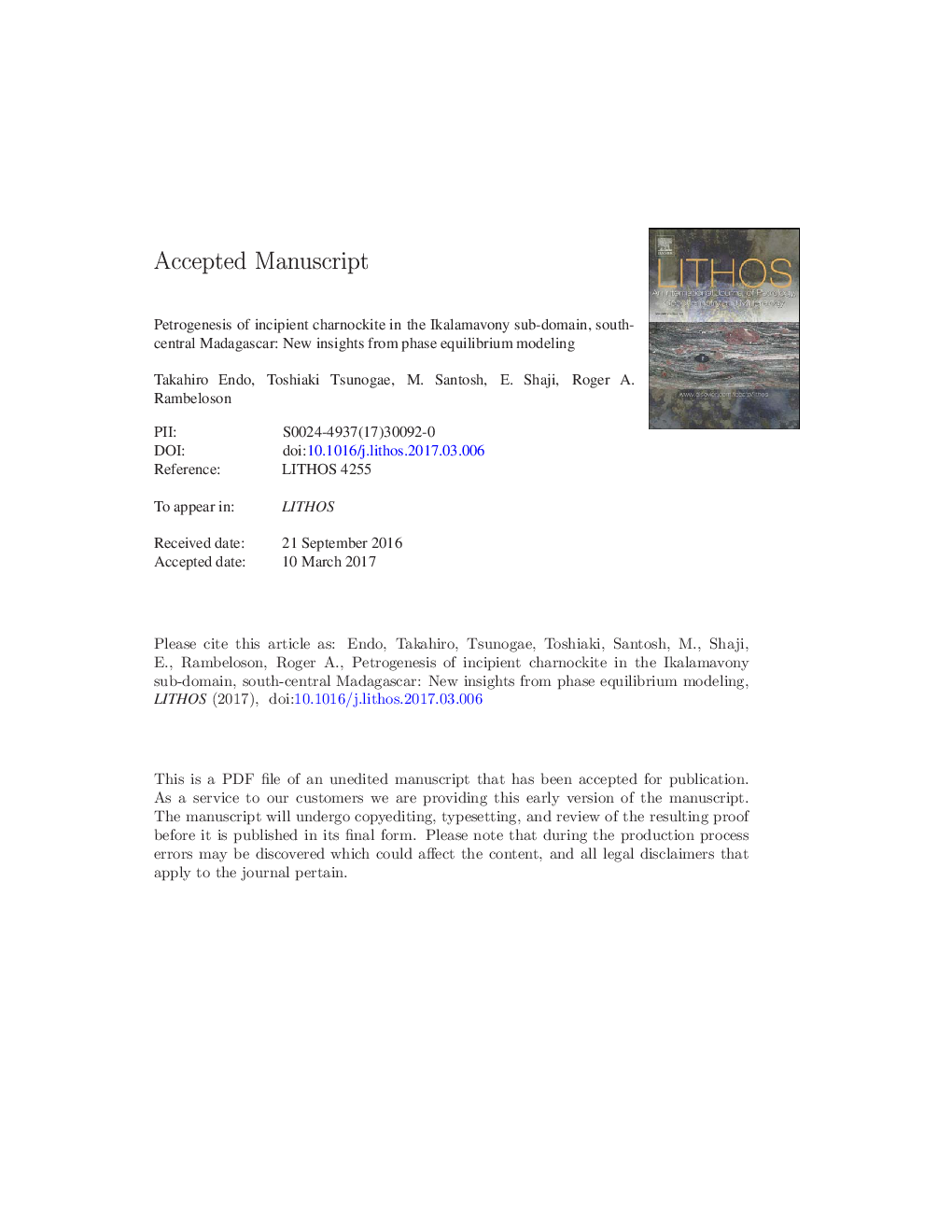| کد مقاله | کد نشریه | سال انتشار | مقاله انگلیسی | نسخه تمام متن |
|---|---|---|---|---|
| 5784144 | 1638631 | 2017 | 50 صفحه PDF | دانلود رایگان |
عنوان انگلیسی مقاله ISI
Petrogenesis of incipient charnockite in the Ikalamavony sub-domain, south-central Madagascar: New insights from phase equilibrium modeling
دانلود مقاله + سفارش ترجمه
دانلود مقاله ISI انگلیسی
رایگان برای ایرانیان
کلمات کلیدی
موضوعات مرتبط
مهندسی و علوم پایه
علوم زمین و سیارات
ژئوشیمی و پترولوژی
پیش نمایش صفحه اول مقاله

چکیده انگلیسی
Incipient charnockites representing granulite formation on a mesoscopic scale occur in the Ambodin Ifandana area of Ikalamavony sub-domain in south-central Madagascar. Here we report new petrological data from these rocks, and discuss the process of granulite formation on the basis of petrography, mineral equilibrium modeling, and fluid inclusion studies. The incipient charnockites occur as brownish patches, lenses, and layers characterized by an assemblage of biotite + orthopyroxene + K-feldspar + plagioclase + quartz + magnetite + ilmenite within host orthopyroxene-free biotite gneiss with an assemblage of biotite + K-feldspar + plagioclase + quartz + magnetite + ilmenite. Lenses and layers of calc-silicate rock (clinopyroxene + garnet + plagioclase + quartz + titanite + calcite) are typically associated with the charnockite. Coarse-grained charnockite occurs along the contact between the layered charnockite and calc-silicate rock. The application of mineral equilibrium modeling on the mineral assemblages in charnockite and biotite gneiss employing the NCKFMASHTO system as well as fluid inclusion study on coarse-grained charnockite defines a P-T range of 8.5-10.5 kbar and 880-900 °C, which is nearly consistent with the inferred P-T condition of the Ikalamavony sub-domain (8.0-10.5 kbar and 820-880 °C). The result of T versus H2O activity (a(H2O)) modeling demonstrates that orthopyroxene-bearing assemblage in charnockite is stable under relatively low a(H2O) condition of 0.42-0.43, which is consistent with the popular models of incipient-charnockite formation related to the lowering of water activity and stabilization of orthopyroxene through dehydration of biotite. The occurrence of calc-silicate rocks adjacent to the charnockite suggests that the CO2-bearing fluid that caused dehydration and incipient-charnockite formation might have been derived through decarbonation of calc-silicate rocks during the initial stage of decompression slightly after the peak metamorphism. The calc-silicate rocks might have also behaved as a cap rock that trapped CO2 infiltrated from an external source. 'CO2-rich fluid ponds' formed beneath calc-silicate layers could have enhanced dehydration of biotite to orthopyroxene, and produced layers of coarse-grained charnockite adjacent to calc-silicate layers.
ناشر
Database: Elsevier - ScienceDirect (ساینس دایرکت)
Journal: Lithos - Volumes 282â283, June 2017, Pages 431-446
Journal: Lithos - Volumes 282â283, June 2017, Pages 431-446
نویسندگان
Takahiro Endo, Toshiaki Tsunogae, M. Santosh, E. Shaji, Roger A. Rambeloson,